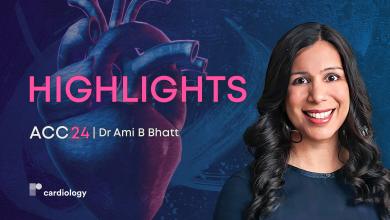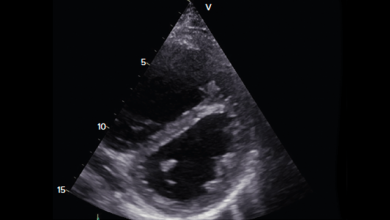Search results
Author(s):
Ami Bhatt
Added:
1 week ago
ACC 2024 — Dr Ami B Bhatt, Chief Innovation Officer of ACC, joins us to highlight key information regarding artificial intelligence innovations in cardiology in 2024.Dr Bhatt discusses the potential progress and innovation that artificial intelligence can provide in clinical medicine, including risk predictions, artificial intelligence use in EKGs, large language models and virtual learning…
View more
Author(s):
Michael H Picard
Added:
3 years ago
Non-invasive imaging of the heart continues to evolve and improve. Cardiovascular ultrasound (echocardiography) continues to play an important role in the diagnosis and assessment of responses to therapy of many cardiac conditions. Even as the clinical applications of newer techniques such as cardiac computed tomography (CT) and cardiac magnetic resonance imaging (CMRI) increase, the role of…
View more
Author(s):
Burkhard Hügl
,
Zdravena Findeisen
Added:
3 years ago
Abstract
The advantages of intracardiac echocardiography (ICE) include shorter procedure times, reduced radiation exposure and the elimination of the need for general anesthesia. It is also effective in the safe performance of transseptal punctures. These have led to its increasing use in electrophysiology (EP) procedures. The use of ICE provides unrestricted access to the cardiac anatomy and…
View more
Author(s):
Sanjiv Kaul
Added:
3 years ago
Contrast echocardiography (CE) is 40 years old this year. Gamiak and Shah first described the use of ultrasound (US) contrast in 1968 during the early days of M-mode echocardiography.1 In that study, US contrast was produced by inadvertently introducing air bubbles in the indocyanine green solution that was injected into the left heart during cardiac catheterisation and observing its appearance…
View more
Author(s):
Cesare Rusconi
Added:
3 years ago
The pump function of the heart resides on two main abilities that allow the entire organism to cope with and face different physiological circumstances from sleep to intense physical exercise of sport activities:
a) diastolic function, defined as the ability of the ventricles to relax and to accept the normal stroke volume at the low pressures existing in the systemic and pulmonary veins; and
…
View more
Author(s):
Angelos Tsipis
,
Evdokia Petropoulou
Added:
2 years ago
Author(s):
Jennifer S Li
,
YT Chen
,
Claire Morgan
,
et al
Added:
3 years ago
Overview
Pompe disease, also known as glycogen storage disease type II or acid maltase deficiency, is a rare, debilitating, and often fatal lysosomal storage disease. It is caused by an autosomal recessively inherited deficiency of the enzyme acid α-glucosidase (GAA) that hydrolyzes glycogen to glucose in the lysosome; the deficiency causes the deposition of glycogen in multiple tissues,…
View more
Transesophageal Echocardiography
Author(s):
Bijoy K Khandheria
Added:
3 years ago
Article
Author(s):
Michael F Morris
,
Philip A Araoz
Added:
3 years ago
Mitral valve dysfunction is the most common cause of valvular disease in the US.1 Although echocardiography is the primary non-invasive modality for visualizing the mitral valve, advances in technology continue to allow for improved evaluation of mitral disease with magnetic resonance imaging (MRI) and computed tomography (CT).2,3 Currently, the role for MRI and CT assessment of the mitral valve…
View more
Author(s):
Matthew R Weir
Added:
3 years ago
The lower level to which blood pressure should be taken and how soon treatment should be started are key considerations where aging and cardiovascular mortality risks are concerned. It has long been taught that blood pressure should be allowed to rise to a level deemed pre-hypertensive or hypertensive before non-pharmacological and pharmacological therapy is embarked upon. Is this really the…
View more











 « First
« First